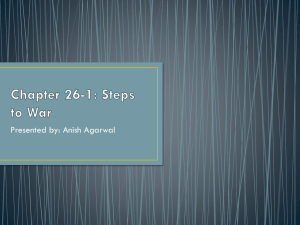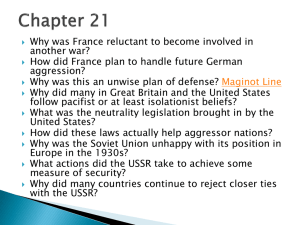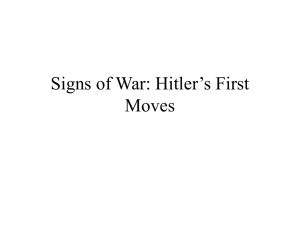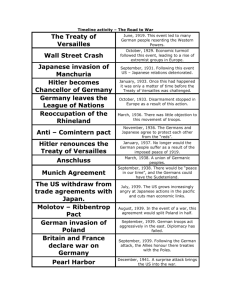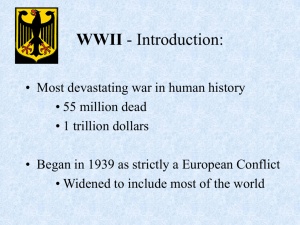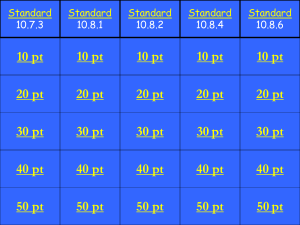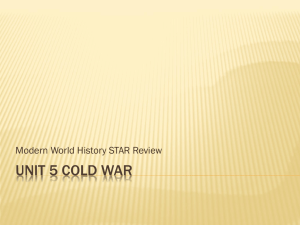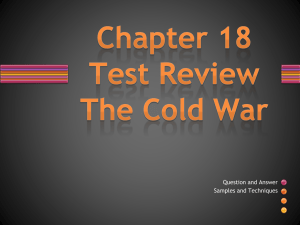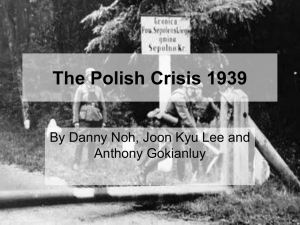Aggression Leads to War: The Onset of World War II in - pams
advertisement
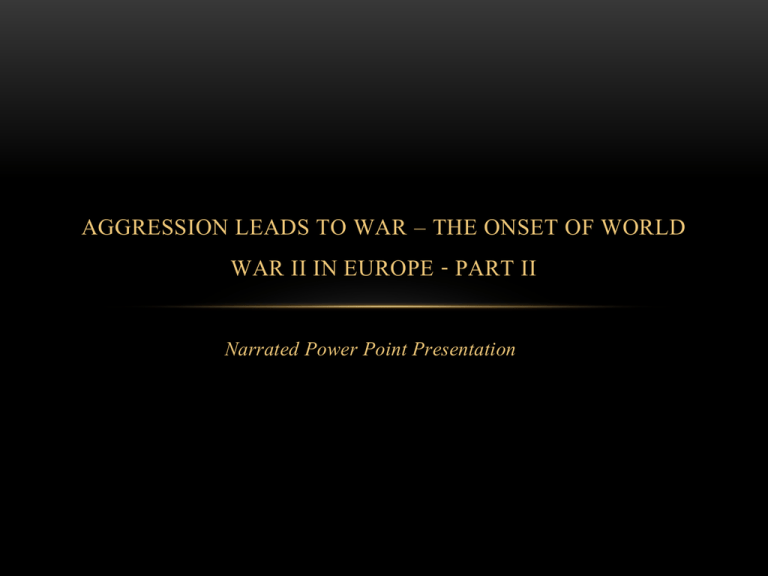
AGGRESSION LEADS TO WAR – THE ONSET OF WORLD WAR II IN EUROPE - PART II Narrated Power Point Presentation APPEASEMENT Appeasement is the official policy of giving in to, or ceding to the demands of, an aggressive nation in order to avoid war. During the 1930s, European nations and the League of Nations – who had the power to intervene against Adolf Hitler – hoped that the Nazis would be satisfied when they allowed Germany to take over Austria and the Sudetenland. Meanwhile, in the United States, Franklin Roosevelt was hampered by a population and a Congress which was steadfastly devoted to isolationism and neutrality, allowing Nazi Germany to gain strength. Hitler took the Sudetenland and the rest of Czechoslovakia, too. THE MUNICH PACT AND THE POLICY OF APPEASEMENT In the Munich Pact, British Prime Minister Neville Chamberlain agreed to allow Hitler to take over all of the Sudetenland in Czechoslovakia. Hitler had contended that the land was German in population and therefore should be ruled over by Germany. In exchanged, he promised not to invade any other nations – and not to take over the rest of Czechoslovakia. The policy, which Chamberlain believed would guarantee “peace in our time” was quickly ignored by Hitler – he took over Czechoslovakia almost immediately. GERMAN AGGRESSION, 1939 By the year 1939, Germany had rebuilt its military, occupied the Rhineland, funded a war in Spain, taken over all of Austria by extortion, seize the Sudetenland, captured all of Czechoslovakia, and, in September of 1939, invaded Poland, starting World War II. US FOREIGN POLICY The United States continued to follow a foreign policy of isolationism during the 1920s and 1930s. Fearful that they may be dragged into another European War, the US passed Neutrality Acts which forbid the sale of weapons or military equipment to rival nations in Europe – and Americans watched silently as Nazi Germany emerged as a dominant world power and a dangerous rogue nation – all in violation of the Treaty of Versailles. THE NON-AGGRESSION PACT OF 1939 Much to the surprise of the rest of the world bitter enemies Germany and the Soviet Union signed a peace treaty in 1939 – the Molotov-Ribbentrop NonAggression Pact. With Germany in cahoots now with Italy, Japan, and the Soviet Union, it seemed that all of the world’s dictators had joined forces to suppress freedom. Democracies were justifiably frightened. SEPTEMBER 1, 1939 - GERMANY INVADES POLAND The German invasion of Poland from the West coincided with a Soviet Invasion from the East – and as a result, Polish resistance was rapidly crushed. The nation would be devastated by the war, with both German and Soviet Armies occupying the land and violating the liberties of its people. Poland would not experience true independence again until the late 1980s. THE RUSSO-GERMAN ALLIANCE, 1939 Since German Nazism and Soviet Communism were two rival philosophies and each nation had a brutal dictator for its leader, most European observers correctly predicted that the relationship would end in betrayal. Germany would eventually violate the Non-Aggression Pact and invade the Soviet Union – Operation Barbarossa began in the Summer of 1940. But in the meantime, The Soviet Union took advantage of the agreement to conquer some territory of their own. ENGLAND AND FRANCE DECLARE WAR Horrified by the brutal repression of the Polish people, England and France both declared war on Germany. Yet, both nations refused to declare war on the equally aggressive Soviet Union. They correctly predicted that the Soviet Union would be betrayed by Hitler – and knew they would likely need another ally, no matter their ilk. ESTONIA, LATVIA, LITHUANIA, FINLAND, AND POLAND WERE INVADED BY THE U.S.S.R. ENGLAND AND FRANCE AT WAR • When the war finally came, both Great Britain and France were overwhelmed by the massive German onslaught. • The German blitzkrieg, or “Lightening War,” devastated the advanced forces of the British and French armies so completely that they were forced to retreat. • The English and French were pinned down at Dunkirk, an isolated beach along the English Channel, where they were surrounded and preparing to be routed or surrender. • The people of England organized every fishing vessel, yacht, ferry and cruise liner in the nation, though, to evacuate as many soldiers as possible to fight another day. • Over 300,000 soldiers were evacuated and saved. DUNKIRK THE GERMANS CAPTURE PARIS, JUNE 22, 1940 PRIME MINISTER WINSTON CHURCHILL “We have before us an ordeal of the most grievous kind. We have before us many, many long months of struggle and of suffering. You ask, what is our policy? I will say: It is to wage war, by sea, land, and air, with all our might and with all the strength that God can give us; to wage war against a monstrous tyranny never surpassed in the dark, lamentable catalogue of human crime. That is our policy. You ask, what is our aim? I can answer in one word: It is victory, victory at all costs, victory in spite of all terror, victory, however long and hard the road may be!” THE BATTLE OF BRITAIN OPERATION BARBAROSSA: THE INVASION OF THE SOVIET UNION – JUNE, 1941 WINSTON CHURCHILL AND JOSEF STALIN BY DECEMBER OF 1941, THE UNITED STATES WOULD JOIN AND UNEASY TRIO: THE ALLIES AGAINST THE AXIS POWERS
